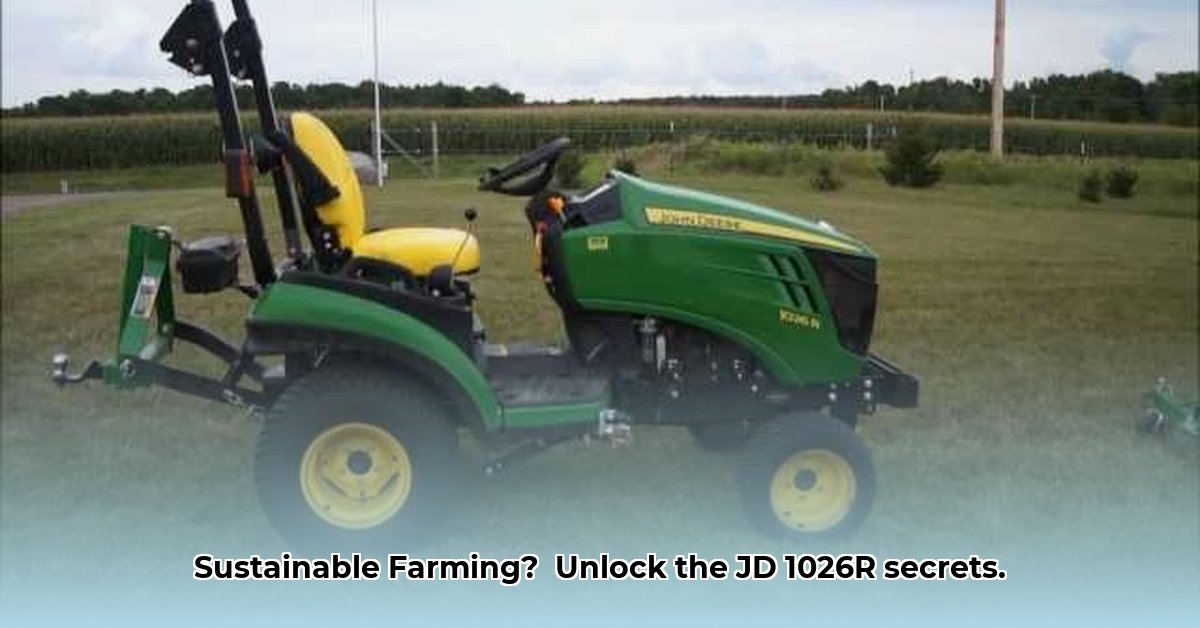
John Deere 1026R: A Sustainable Farming Review
The John Deere 1026R sub-compact tractor has gained popularity among small-scale farmers, but its suitability for sustainable practices requires careful consideration. This review analyzes its strengths and weaknesses, offering a data-driven assessment of its environmental impact and long-term viability. For more on new John Deere tractors, see this page.
Fuel Efficiency: A Key Sustainability Factor
The 1026R's 1.1-liter, three-cylinder Yanmar diesel engine is notably fuel-efficient compared to larger tractors. This translates to lower greenhouse gas emissions, a significant advantage for environmentally conscious farmers. But how does this compare to competitors? Independent testing and user reviews will be crucial for a truly informed assessment. Have you considered the potential fuel savings over the tractor's lifespan?
Minimizing Soil Compaction: A Healthy Soil Foundation
The 1026R's compact size and lighter weight minimize soil compaction compared to larger machines. This aspect is critical for long-term soil health, leading to improved water absorption, nutrient retention, and ultimately, better crop yields. Reduced compaction also means less need for expensive soil remediation. What are the quantifiable benefits of reduced soil compaction in your specific farming context?
Versatility and Efficiency: A Multi-purpose Machine
The 1026R's versatility is a significant asset. Its compatibility with various implements reduces the need for a large fleet of specialized machinery, lowering both initial investment costs and ongoing maintenance requirements. This contributes to its overall sustainability profile by reducing environmental impact across the farming operation. How many specialized implements do you currently use, and how might the 1026R consolidate those needs?
Maintenance and Longevity: A Long-Term Perspective
While the 1026R's fuel efficiency and low compaction are advantageous for sustainability, its age (introduced around 2011) presents a potential challenge. Finding replacement parts and timely repairs may become more difficult and expensive over time. This factor should be factored into the overall long-term sustainability equation of the tractor. What is your strategy for sourcing parts and ensuring timely maintenance for older equipment?
Buying and Maintaining Your John Deere 1026R: A Practical Guide
Buying a Used 1026R: A Step-by-Step Guide
- Thorough Pre-Purchase Inspection: Conduct a complete visual inspection, checking for wear, leaks, and prior repairs.
- Professional Mechanic's Assessment: Hire a qualified mechanic to conduct a comprehensive inspection, assessing the engine, hydraulic system, and transmission.
- Parts Availability Research: Investigate the availability of replacement parts from John Deere dealers or reputable online suppliers; factor potential costs into your budget.
- Documentation Review: Request thorough service records, maintenance logs, and ownership history to understand the tractor's past use and condition.
- Test Drive: Perform a comprehensive test drive under various conditions to evaluate handling, responsiveness, and noise levels.
Maximizing Your 1026R's Sustainability: Operational Strategies
- Regular Maintenance: Adhere diligently to the manufacturer's recommended maintenance schedule to prevent breakdowns, optimize performance, and extend the tractor's lifespan.
- Tire Pressure Optimization: Maintain correct tire pressure to minimize fuel consumption and reduce soil compaction.
- Efficient Operation: Avoid idling; plan work routes to reduce travel time and fuel waste.
- Appropriate Implement Selection: Select the correct implements for each task to enhance efficiency and reduce wear and tear.
Comparing the John Deere 1026R to Competitors: Fuel Efficiency Considerations
Direct comparisons of fuel efficiency among similar-sized tractors are difficult due to inconsistencies in manufacturer data and varying operating conditions. However, factors such as engine size, operator skill, terrain, and implement selection significantly influence fuel consumption. Remember, a powerful engine might consume more fuel but complete tasks faster, potentially leading to better overall fuel efficiency depending on your specific tasks.
Key Takeaways:
- The 1026R's fuel economy is a trade-off between power and efficiency.
- Independent testing and user feedback are necessary for accurate comparisons.
- Proper operation and maintenance significantly affect fuel consumption.
- Consider the long-term cost of parts and repairs when assessing sustainability.
This review provides a balanced assessment of the John Deere 1026R's suitability for sustainable farming. While offering significant advantages in fuel efficiency and soil conservation, potential challenges related to parts availability and longer-term maintenance should be carefully considered before purchase.